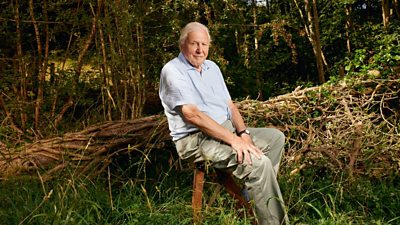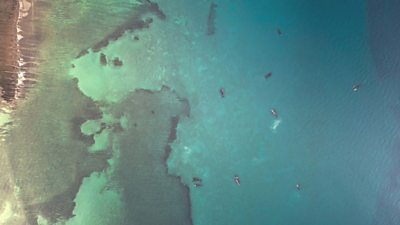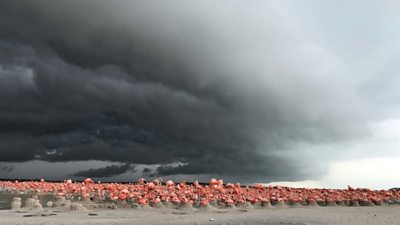In this new series of Planet Earth we travel to the most astonishing wild places, see mysterious creatures, witness rare, spectacular wonders, and reveal breath-taking animal dramas. The natural world continues to surprise us, but since Darwin’s time it has changed beyond recognition, being transformed by a powerful force – us. We will see how animals are adapting in extraordinary ways, to survive the new challenges they face. At this crucial time in our history, we must now look at the world through a new lens.
Sir David Attenborough presents Planet Earth III, a brand new Natural History series for BBC One and iPlayer. Journeying to the far reaches of our planet, this eight part series follows some of the world’s most amazing species, telling extraordinary stories that are dramatic, thrilling, funny and sometimes heart-breaking, but always full of hope.
Filmed over the course of nearly five years, the new series uses pioneering filmmaking technology to reveal the greatest wonders of life on earth. Lightweight drones, high-speed cameras and remotely operated deep-sea submersibles transport viewers to spectacular unseen landscapes, from remote jungle to scorching deserts, and from the darkest caves to the depths of the ocean.
Nearly two decades since the original series of Planet Earth aired on BBC One, we see how science and technology has advanced, but also how our planet has changed. We’ve reached a critical point in our planet’s history and the natural world has changed more over the past few decades than ever previously observed in our human history. These changes have been felt across every ecosystem and by the countless creatures that we share this planet with.*
AT2
When is Planet Earth III on TV and BBC iPlayer?
Planet Earth III will begin on BBC One and BBC iPlayer on Sunday 22 October from 6.15pm
Watch the trailer
Planet Earth III Episodes Overview

- Episode 1 - Coasts
- Episode 2 - Ocean
- Episode 3 - Deserts and Grasslands
- Episode 4 - Freshwater
- Episode 5 - Forests
- Episode 6 - Extremes
- Episode 7 - Human
- Episode 8 - Heroes
Planet Earth III in numbers
- Total number of filming days: 1,904
- Total number of shoots: 134
- Total number of shoots managed remotely: 50
- Total number of countries filmed in: 43 countries across six continents
- Crew: Crew from 27 countries were involved with this production
- Rarest animal filmed: Morona-Santiago Harlequin Frog (Atelopus halihelos), appears in episode eight, there are no more than 49 individuals left.*
- Fun fact: When filming for series one of Planet Earth, the crew famously mounted a camera to a hot air balloon to film trees from above (it didn’t end well).* Since then, drone technology has revolutionised aerial filming, and small, lightweight drones were used for many of the shoots in this series.
Q&A with Mike Gunton, Executive Producer

Mike Gunton is the Creative Director of Factual and The Natural History Unit for BBC Studios. Within this role, Mike works as an executive producer on titles for the BBC, Apple, NBC, and Nat Geo/Disney+, and is responsible for bringing new and pioneering stories about the natural world to global audiences. Mike’s recent series include the record-breaking Planet Earth II, winner of four BAFTAs and two Emmys, followed by the ground-breaking animal behaviour series Dynasties. In 2022 he turned his attention to the world of plants in The Green Planet, and the world of dinosaurs with Prehistoric Planet.
How does Planet Earth III build upon the previous series of Planet Earth?
The first series of Planet Earth was about witnessing the wonderful spectacle and awe-inspiring beauty of our planet and taking the viewer to the last remaining areas of wilderness that were still untouched by humanity.
Planet Earth II was about connecting the viewer intimately with the animals, to be alongside them, experiencing their triumphs and their struggles.
Planet Earth III is about the resilience and adaptability of nature, and the remarkable animals that are changing their lives to meet the challenges of a rapidly changing world dominated more than ever by a powerful force: us. It’s full of surprise and wonder but seen from a new perspective.
Did you have any unique wildlife encounters during filming for this series?
My answer might surprise you because it doesn’t involve a remote location or an exotic species. It was actually a very simple moment. Our final day of filming for the series was with David in a quintessential English flower meadow on a sunny late summer's day. It was the very meadow that Charles Darwin used to observe and explore while he ruminated on his theories about the natural world and evolution. The meadow was alive with bees and insects, grasshoppers were singing out their melodies all around us and there was an abundance of butterflies floating on the warm air. Both David and I said it was truly magical and it gave me hope that if we can protect and restore and allow nature to work its miracles, then future generations will be able experience that magic for many years to come.
What was it like to work with David Attenborough again?
It was a privilege as always. David was able to bring the wisdom, enthusiasm, knowledge and, in places, the fun we needed for this series. At 97, he still possesses a unique ability to immediately captivate the viewer with his presence and his words. He was passionate about the stories we needed to tell and wanted to be part of the show from the outset.
How do you maintain a balance between due concern and wide-eyed wonder?
This has always been something we have had to grapple with - to connect the viewer to the places and the animals we film in a way that cannot fail to create affinity and empathy, while at the same time exploring the harder truths in a way that does not make people want to turn away, or leave them feeling helpless. I think audiences now, more than ever, want to know the truth, they want to understand it, and they look to us for answers. We hold a great responsibility as filmmakers to create that spark of deep passion for our natural world, and to bear witness to the challenges that it now faces.
What do you hope personally that people will take away from this new series?
That we are pushing species, habitats and individual animals to the brink of their ability to survive and adapt, but the natural world has an extraordinary capacity to heal itself if we give it the chance. We need to make space, make sacrifices and use our remarkable human ingenuity and creativity to bring change for the benefit of these wild places and wild animals, and ourselves.
Q&A with Matt Brandon, Series Producer

Matt Brandon is a BAFTA winning series producer responsible for delivering a broad range of highly successful natural history and adventure documentaries for broadcasters including BBC, Disney+, National Geographic, Discovery Channel, and Animal Planet. Matt started his career at the BBC more than 25 years ago. Amongst other projects, he has produced series about Australia, the Caribbean, and the Indian Ocean with explorer Simon Reeve; and travelled the Amazon River from Source to Sea with Bruce Parry. Matt's recent landmark shows include Cities: Nature's New Wild for the Natural History Unit, and Emmy-nominated Super/Natural for Disney + and National Geographic, executive produced by James Cameron.
What is your favourite moment from the series?
It’s funny because I think my answer might be the same as Mike’s. That day we spent filming at Downe Bank Nature Reserve in Kent, with David, was just one of the most glorious days we had on set. It was peaceful, the sun was shining, the air was filled with butterflies and the grass was humming with life. As natural history filmmakers we are lucky enough to travel all over the world, but I’m equally amazed by the wildlife here at home. We must remember to appreciate the wildlife we have on our doorstep - it’s so special and needs our protection just as much as wildlife overseas.
You have said this series may be the most ambitious Planet Earth series ever made – why is that?
Well for a start we spent 1,904 days filming!
This included…weeks spent in hides on the freezing plains of the Eurasian Steppe where temperatures drop to minus 30 degrees Celsius; nearly a month in the caustic waters of Mexico’s Yucatan peninsula to produce a stunning new story about a nesting flamingo colony; trekking for two days through the Vietnamese jungle with 500 kgs of equipment to reach the world’s largest natural cave, Hang son Doong, where the team then lived for 18 days underground (longer than anyone has ever spent in the cave before); and filming two miles below the surface of the sea using a deep sea submersible to reveal the first broadcast footage of the largest known gathering of octopus in the world.
The music for this series is composed by Hans Zimmer and Bleeding Fingers, in collaboration with Bastille. What does the music bring to a natural history series like this?
The drama and spectacle of our natural world deserves an epic score to match. Who better than Hans Zimmer and his collaborators? He’s a master at picking up on the personalities of our cast, and composing the perfect charismatic scores as the soundtrack to their lives. After years in the field capturing the footage, it’s hard to explain the moment you see the finished episode for the first time, with the music and with David’s narration. It’s simply magical.
And it’s funny because, speaking about the sound more broadly, I got to work with my oldest and closest friend on this series, sound recordist Zubin Sarosh. Many many years ago, we were sitting on a beach and we decided we both wanted to work in telly. It was so amazing to be on set with him, and not just any set, on a David Attenborough documentary. That really is a dream come true - it doesn’t get much better!
This series is about entering a new wild. What does that mean?
We do not shy away from the impact that humanity has had on the natural world. This impact has been felt across every ecosystem and by the countless creatures that we share this planet with – some
scientists are calling this the Anthropocene. Many animals simply cannot keep up with the pace of change, while others are adapting to this new wild in extraordinary ways.
In episode seven there is an astonishing shot of a rhino walking through the streets of Sauraha, Nepal, simply to get to food on the other side of town. In Lake Tahoe, USA, black bears foraging for food in the city dumpsters are up to 50% heavier than their country-dwelling counterparts.
It’s more important than ever that we don’t feel hopeless, and celebrate the awe, beauty, and wonder that remains across the planet. This series will bring a new important insight into our increasingly fragile natural world by revealing the deep interconnectivity of all life on Earth.
We’ve also filmed creatures and behaviours that audiences may not have seen before. For instance, a sea angel – a really weird and beautiful looking creature with a devilish side…and a rapacious appetite. And then there is Nimbochromis livingstonii – a fish which tricks other fish into thinking it’s dead; its mottled colouration mimics decaying flesh, and it actually fakes its own death! The team captured this moment on film as it dived into sand and flopped on its side in an Oscar-worthy performance. As far as we know, our team is the first to get this behaviour on camera.
Part of this series was filmed during Covid. Did this interrupt your filming schedule?
It was both a blessing and a curse. Between us, the crew spent a total of 797 days in quarantine - more than two years! But it was also an opportunity that allowed us to learn how to manage more of our shoots remotely, and to work with more talented local producers and cinematographers. 50 out of 134 of our shoots were carried out by local crews, with a member of the Planet Earth III team directing remotely from home. We met great local filmmakers like Abdullah Khan, who is a self-taught cameraman from Pakistan and who filmed the Indus river dolphin for us. Perhaps the funniest example of a remote shoot is the octopus sequence in Ocean – Director Will Ridgeon was at home in Bristol, directing a camera on a remotely operated vehicle thousands of miles away, two miles beneath the surface of the ocean. That certainly wouldn’t have been possible for the original Planet Earth….
Pan BBC sustainability
Planet Earth III expands the conversation about nature loss in Britain and Ireland kick-started by Wild Isles. These series, like Frozen Planet II and The Green Planet, illustrate our commitment to reflecting environmental and sustainability issues in the content we make and broadcast, so it’s important to us that they are also embedded in the way we operate and run the BBC.
We are working on solutions to reduce greenhouse gas (GHG) emissions produced by our own industry, to protect the biodiversity of the world we interact with, while also enhancing our audiences’ understanding of climate change and what’s needed to transition to Net Zero.
Our aim is to meet the Science Based Targets (SBTs) approved for the BBC in 2021, which commit us to cutting our GHG emissions to Net Zero following a clear pathway to avoid the worst impacts of climate change.
We’re also focussed on protecting the natural world around us. Currently, we’re aligning to a framework set out by the Taskforce for Nature-related Financial Disclosures (TNFD) which guides organisations in reporting on the risks from biodiversity loss and ecosystem degradation. As part of the project, the BBC is investigating its own operational impact on the environment and we have conducted an initial biodiversity footprint study, in conjunction with a specialist team from the University of Oxford.
More details on our work to become a Net Zero broadcaster are available on the BBC’s sustainability website.
Notes
Series credits
Planet Earth III will begin on BBC One and iPlayer on Sunday 22nd October.
Planet Earth III, an 8x60’ series made by BBC Studios Natural History Unit, co-produced by BBC America, ZDF, FTV and The Open University. The Executive Producer is Mike Gunton and the Series Producer is Matt Brandon. It was commissioned by Jack Bootle Head of Commissioning, Specialist Factual.
Music and Podcast Information
The score is composed by Hans Zimmer and his long term collaborators Bleeding Fingers Music, in collaboration with British band Bastille and the BBC National Orchestra of Wales.
Fans of Planet Earth III will also be able to listen to the Planet Earth Podcast (w/t), coming soon on BBC Sounds and BBC Radio 4, featuring surprising insights and fascinating stories from Sir David Attenborough about the three Planet Earth series, as well as his wider career.
Sources
*The natural world has changed more over the past few decades than ever previously observed in our human history. This change has been felt across every ecosystem and by the countless creatures that we share this planet with [Source: Natural History Museum]
*No more than 49 individuals of Morona-Santiago Harlequin Frog [Source: IUCN Red List]
*For series one of Planet Earth, the crew mounted a camera to a hot air balloon to film trees from above. [Source: archive, see also IMDB]
